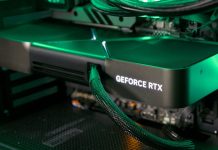Intel’s dedicated GPUs are back for another round, and they’re aiming for 1440p.

Intel’s next-gen B-series dedicated GPUs are launching soon, with the decidedly midrange B500-series cards out in front. Credit: Intel
Turnover at the top of the company isn’t stopping Intel from launching new products: Today the company is announcing the first of its next-generation B-series Intel Arc GPUs, the Arc B580 and Arc B570.
Both are decidedly midrange graphics cards that will compete with the likes of Nvidia’s GeForce RTX 4060 and AMD’s RX 7600 series, but Intel is pricing them competitively: $249 for a B580 with 12GB of RAM and $219 for a B570 with 10GB of RAM. The B580 launches on December 13, while the B570 won’t be available until January 16.
The two cards are Intel’s first dedicated GPUs based on its next-generation “Battlemage” architecture, a successor to the “Alchemist” architecture used in the A-series cards. Intel’s Core Ultra 200 laptop processors were its first products to ship with Battlemage, though they used an integrated version with fewer of Intel’s Xe cores and no dedicated memory. Both B-series GPUs use silicon manufactured on a 5 nm TSMC process, an upgrade from the 6 nm process used for the A-series; as of this writing, no integrated or dedicated Arc GPUs have been manufactured by one of Intel’s factories.
Both cards use a single 8-pin power connector, at least in Intel’s reference design; Intel is offering a first-party limited-edition version of the B580, while it looks like partners like Asus, ASRock, Gunnir, Maxsun, Onix, and Sparkle will be responsible for the B570.


The Arc B580 will be available in a limited-edition design from Intel.Intel
Intel’s partners will handle the other cards, including all versions of the B570. The B580 and B570 will launch for $249 and $219, respectively.Intel
Compared to the original Arc GPUs, both Battlemage cards should benefit from the work Intel has put into its graphics drivers over the last two years—a combination of performance improvements plus translation layers for older versions of DirectX have all improved Arc’s performance quite a bit in older games since late 2022. Hopefully buyers won’t need to wait months or years to get good performance out of the Battlemage cards.
Ars Video
How The Callisto Protocol’s Gameplay Was Perfected Months Before Release
The new cards also come with XeSS 2, the next-generation version of Intel’s upscaling technology (analogous to DLSS for Nvidia cards and FSR for AMD’s). Like DLSS 3 and FSR 3, one of XeSS 2’s main additions is a frame-generation feature that can interpolate additional frames to insert between the frames that are actually being rendered by the graphics card. These kinds of technologies tend to work best when the cards are already running at a reasonably high frame rate, but when they’re working well, they can lead to smoother-looking gameplay. A related technology, Xe Low Latency, aims to reduce the increase in latency that comes with frame-generation technologies, similar to Nvidia’s Reflex and AMD’s Anti-Lag.
Targeting 8GB GPUs
Both the Nvidia and AMD cards in this sub-$300 price range top out at 8GB of RAM, something Intel is targeting with its marketing for the new cards. When Intel says the B580 performs about 10 percent better on average than the RTX 4060, it’s running those tests at 1440p, a resolution where games will begin running into that 8GB RAM limit more regularly than they will at 1080p.
Nvidia’s cheapest current-gen card with more than 8GB of RAM is the 16GB version of the 4060 Ti (roughly $450 as of this writing), while AMD offers a 16GB version of the less-powerful RX 7600 XT for around $320. The Intel cards offer less RAM than this but undercut them significantly on price while still providing more than 8GB.

Intel says the B580 is about 10 percent faster than the RTX 4060, at least at 1440p. Intel


The B580 is also about 24 percent faster than the Arc A750 at 1440p, though we don’t know whether to expect a B750 or B770. Intel
Intel is aiming for performance-per-dollar here, particularly when it comes to ray-traced performance.Intel
Intel’s promotional slides point out that this RAM bump is particularly relevant when ray tracing is turned on and can make the difference between the Arc card running behind the RTX 4060 and running ahead of it. (Intel also points out that its midrange ray-tracing performance is a significant step up over AMD’s.)
Generation over generation, Intel claims that the B580 is around 24 percent faster on average than the last-generation Arc A750, another 8GB card. Intel didn’t provide performance comparisons to the 16GB Arc A770 card, although we’ll compare the two cards in our review.
Intel isn’t talking about any other B-series GPUs today, but launching the 500-series cards first implies that we could see B700-series GPUs at some point next year that attempt to compete with higher-end Nvidia cards like the 4060 Ti or 4070. That said, Nvidia is expected to begin launching the RTX 5000 series early next year, so Nvidia’s midrange lineup is a bit of a moving target at the moment.




